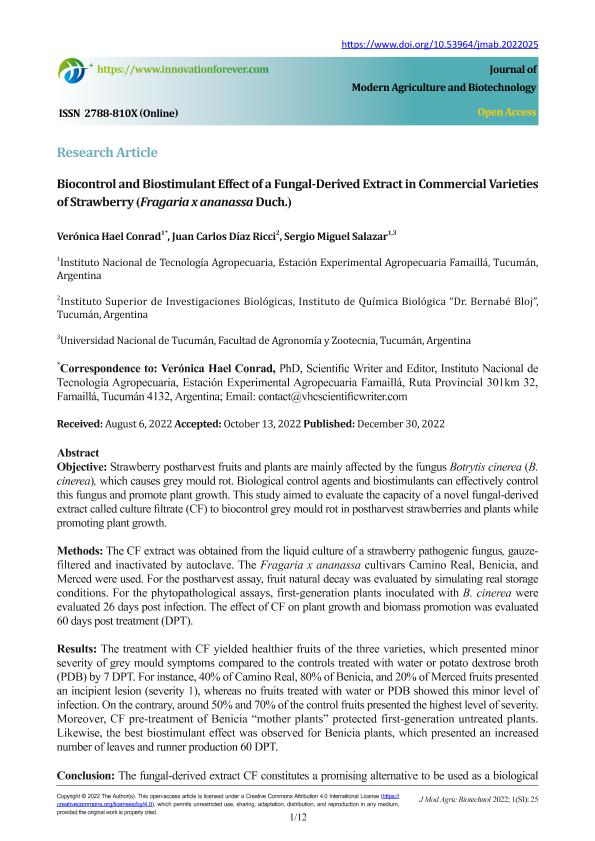Mostrar el registro sencillo del ítem
dc.contributor.author
Hael Conrad, Verónica

dc.contributor.author
Diaz Ricci, Juan Carlos

dc.contributor.author
Salazar, Sergio Miguel

dc.date.available
2024-02-27T15:35:36Z
dc.date.issued
2022-12
dc.identifier.citation
Hael Conrad, Verónica; Diaz Ricci, Juan Carlos; Salazar, Sergio Miguel; Biocontrol and Biostimulant Effect of a Fungal-Derived Extract in Commercial Varieties of Strawberry (Fragaria x ananassa Duch.); Innovation Forever Publishing Group; Journal of Modern Agriculture and Biotechnology; 1(SI); 25; 12-2022; 1-12
dc.identifier.issn
2788-810X
dc.identifier.uri
http://hdl.handle.net/11336/228648
dc.description.abstract
Objective: Strawberry postharvest fruits and plants are mainly affected by the fungus Botrytis cinerea (B. cinerea), which causes grey mould rot. Biological control agents and biostimulants can effectively control this fungus and promote plant growth. This study aimed to evaluate the capacity of a novel fungal-derived extract called culture filtrate (CF) to biocontrol grey mould rot in postharvest strawberries and plants while promoting plant growth.Methods: The CF extract was obtained from the liquid culture of a strawberry pathogenic fungus, gauzefiltered and inactivated by autoclave. The Fragaria x ananassa cultivars Camino Real, Benicia, and Merced were used. For the postharvest assay, fruit natural decay was evaluated by simulating real storage conditions. For the phytopathological assays, first-generation plants inoculated with B. cinerea were evaluated 26 days post infection. The effect of CF on plant growth and biomass promotion was evaluated 60 days post treatment (DPT).Results: The treatment with CF yielded healthier fruits of the three varieties, which presented minorseverity of grey mould symptoms compared to the controls treated with water or potato dextrose broth (PDB) by 7 DPT. For instance, 40% of Camino Real, 80% of Benicia, and 20% of Merced fruits presented an incipient lesion (severity 1), whereas no fruits treated with water or PDB showed this minor level of infection. On the contrary, around 50% and 70% of the control fruits presented the highest level of severity. Moreover, CF pre-treatment of Benicia “mother plants” protected first-generation untreated plants. Likewise, the best biostimulant effect was observed for Benicia plants, which presented an increased number of leaves and runner production 60 DPT.
dc.format
application/pdf
dc.language.iso
eng
dc.publisher
Innovation Forever Publishing Group
dc.rights
info:eu-repo/semantics/openAccess
dc.rights.uri
https://creativecommons.org/licenses/by/2.5/ar/
dc.subject
BIOLOGICAL CONTROL
dc.subject
BOTRYTIS CINEREA
dc.subject
STRAWBERRY
dc.subject
PHYTOVACCINES
dc.subject.classification
Biotecnología Agrícola y Biotecnología Alimentaria

dc.subject.classification
Biotecnología Agropecuaria

dc.subject.classification
CIENCIAS AGRÍCOLAS

dc.title
Biocontrol and Biostimulant Effect of a Fungal-Derived Extract in Commercial Varieties of Strawberry (Fragaria x ananassa Duch.)
dc.type
info:eu-repo/semantics/article
dc.type
info:ar-repo/semantics/artículo
dc.type
info:eu-repo/semantics/publishedVersion
dc.date.updated
2024-02-20T15:03:12Z
dc.journal.volume
1(SI)
dc.journal.number
25
dc.journal.pagination
1-12
dc.journal.pais
China

dc.journal.ciudad
Hong Kong
dc.description.fil
Fil: Hael Conrad, Verónica. Consejo Nacional de Investigaciones Científicas y Técnicas. Centro Científico Tecnológico Conicet - Tucumán. Instituto Superior de Investigaciones Biológicas. Universidad Nacional de Tucumán. Instituto Superior de Investigaciones Biológicas; Argentina. Instituto Nacional de Tecnología Agropecuaria. Centro Regional Tucuman-Santiago del Estero. Estación Experimental Agropecuaria Famaillá; Argentina
dc.description.fil
Fil: Diaz Ricci, Juan Carlos. Consejo Nacional de Investigaciones Científicas y Técnicas. Centro Científico Tecnológico Conicet - Tucumán. Instituto Superior de Investigaciones Biológicas. Universidad Nacional de Tucumán. Instituto Superior de Investigaciones Biológicas; Argentina. Universidad Nacional de Tucumán. Facultad de Bioquímica, Química y Farmacia. Instituto de Química Biológica; Argentina
dc.description.fil
Fil: Salazar, Sergio Miguel. Instituto Nacional de Tecnología Agropecuaria. Centro Regional Tucuman-Santiago del Estero. Estación Experimental Agropecuaria Famaillá; Argentina. Universidad Nacional de Tucumán. Facultad de Agronomía y Zootecnia; Argentina
dc.journal.title
Journal of Modern Agriculture and Biotechnology
dc.relation.alternativeid
info:eu-repo/semantics/altIdentifier/url/https://www.innovationforever.com/article.JMAB20220165
dc.relation.alternativeid
info:eu-repo/semantics/altIdentifier/doi/https://www.doi.org/10.53964/jmab.2022025
Archivos asociados
